Big Sky, Montana
How Big Sky Became an Arts Destination.
“We could be life every other resort town, but we don’t have to be.” -Katie Alvin, Development Director of the Arts Council of Big Sky
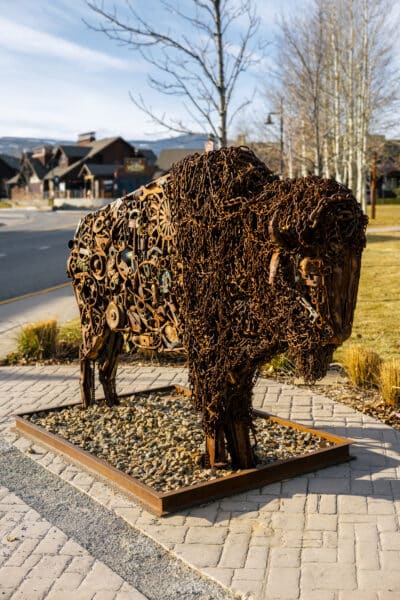
In the fall of 2018, Waldazo—a majestic life-size bison assembled from a collection of donated iron—by Bozeman sculptor Kirsten Kainz was installed in Town Center’s Fire Pit Park. Waldazo challenges viewers to question America’s throw- away culture. Photograph by Nathan Peterson
In a mountain town like Big Sky, our attention is typically drawn to athleticism—skiing, biking, running, boating—or the natural world—summits bathed in alpenglow, chance encounters with wildlife, the night sky at elevation. In that environment, happening upon art unexpectedly breaks us from our routines. In a small way it puts us in an altered state of consciousness, which lowers the heart rate and allows for reflection. Public art is another way that Big Sky connects. When it comes to the arts, says Katie Alvin, Development Director of Arts Council of Big Sky, “we could be like every other resort town, but we don’t have to be.” In Big Sky, artwork doesn’t just exist in galleries, it’s woven into the fabric of the community. Here, stakeholders believe that art builds communities. Montana, in their world view, has the potential to become an arts destination, like Vail, Colorado, or Santa Fe, New Mexico.
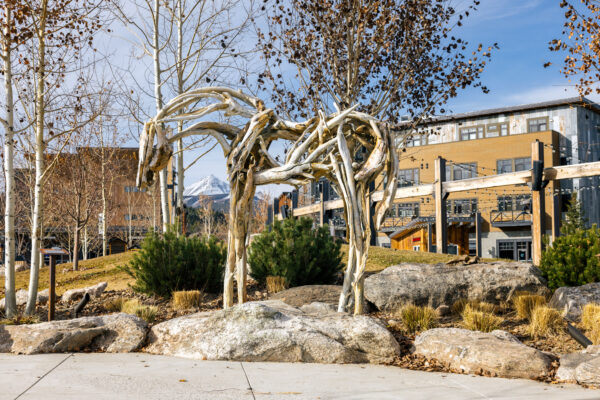
In October of 2018, Big Sky became the first location in Montana to install an outdoor sculpture, Winter, by renowned Montana artist Deborah Butterfield. The recipient of multiple awards, including fellowships from the National Endowment of the Arts and Guggenheim, Butterfield began crafting horse sculptures out of primitive mixed-media materials in the 1970s. Her love for the equine form has resulted in gallery showings across the country and her work has graced museums like The Whitney, The Metropolitan Museum of Art, and the Smithsonian Institution. Made in Butterfield’s Montana studio, Winter was created using driftwood gathered along the banks of the Gallatin, Yellowstone, and Madison rivers, then cast in bronze and patinaed to withstand the elements. Photograph courtesy of Arts Council of Big Sky
Beyond the economic value of art, its primary benefit is in improving the lives of residents, employees, and tourists. By showcasing the work of regional and local artists, public art, says Jesine Munson, Public Art and Outreach Coordinator for Arts Council of Big Sky, lets artists and citizens engage in conversations about Big Sky’s past, present, and future.

Having lived most of his life amidst the serene beauty of the Northwest, Brad Rude’s art pays homage to the natural world that surrounds his Walla Walla studio and home. From dogs to rhinos, Rude’s sculptures often challenge viewers to see the animal world in unconventional terms. Brad’s sculpture, To The Skyland, depicts a lone wolf, alert and in motion, as it leans forward into an unknown future assisted by red wheels and a walking stick. Look for the final To The Skyland across from Town Center Plaza in 2024. Photograph by Nathan Peterson
But public art doesn’t happen without private support. In Big Sky, the arts community forged partnerships to achieve its goals. As Big Sky’s largest property owner, Lone Mountain Land Company has emerged as a key proponent for marrying art and development. “They’ve engaged the community,” says Alvin. “Lone Mountain Land Company’s shared vision of a dedicated art corridor ensures locals and visitors see not only Big Sky’s physical beauty, but its cultural history, too.”
“Lone Mountain Land Company’s shared vision of a dedicated art corridor ensures locals and visitors see not only Big Sky’s physical beauty, but its cultural history, too.” -Katie Alvin, Development Director for Arts Council of Big Sky
Today, the curated public art installments in Big Sky equate to more than $1 million in artwork acquired by citizens through community campaigns, or secured through private donations by individuals and businesses. Big Sky now boasts 11 outdoor sculptures that reflect an eclectic mix of contemporary and natural themes. The Arts Council hopes people will stumble across sculptures—and pause to reflect.
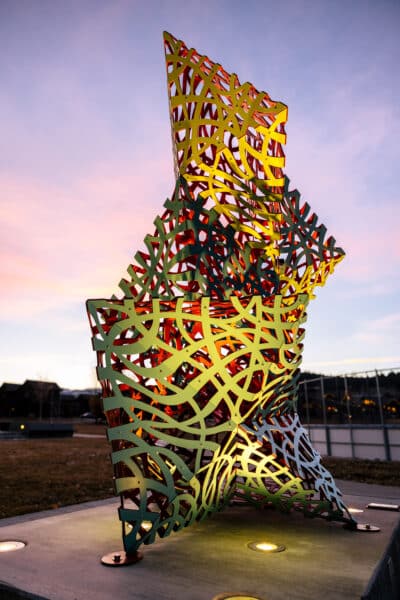
From Vermont to California, Fleming’s work has created
a “space lace” that defies linear structure and norms. “My works hint at the co-existence of the mundane and the cosmological where two realities exist including the possibility that the past is also the present,” Fleming writes. “The structures are diagrams of thought that provide a glimpse of the strangeness beyond the everyday world; opening a place where thought becomes tangible, history leaves a trace, and information exhales form.” Located at the BASE Community Center, Lightning serves as a memorial to Anne Buchanan and other lives lived and lost. Photograph by Nathan Peterson
Big Sky now boasts 11 outdoor structures that reflect an eclectic mix of contemporary and natural themes.
Combined with the Arts Council’s renewed emphasis on education, interactive maps now make it easy to learn about the artists and selection process.
The goal, says Munson, is to “select engaging art that is different, that is interactive, that makes people think.”
“The goal is to select engaging art that is different, that is interactive, that makes people think.” -Jesine Munson, Public Art & Outreach Coordinator for Arts Council of Big Sky
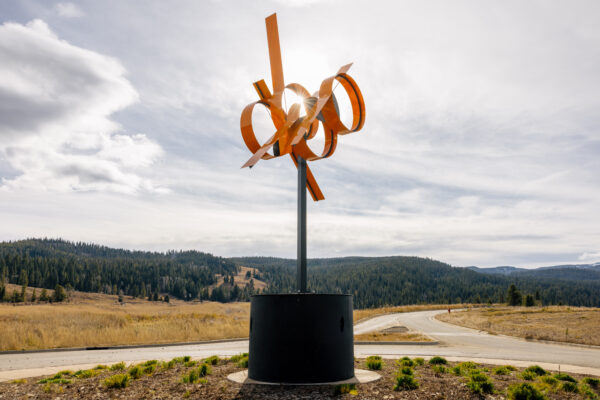
There’s nothing static about Big Sky, the air, light, and seasons constantly shape-shift. It’s no surprise, then, that kinetic sculptor Pedro S. De Movellán’s work, Gibbous, was selected by the Arts Council of Big Sky to grace the roundabout on Huntley Drive and Town Center Avenue. A towering sculpture made of natural hardcoat anodized aluminum, stainless steel, and painted with a bright orange automobile paint, the work’s spherical shapes and movement mirror a gibbous moon fluctuating between half full and full. According to the Davidson Gallery that represents De Movellán, his ability to harness motion through air and wind gives his work a unique and ever-changing dynamic. Photograph by Nathan Peterson
Expect to see more such work soon. Artist Brad Rude’s accessible and engaging bronze sculpture, To The Skyland, will be installed on a walking path across from Town Center Plaza in 2024. A collaboration with the Gallatin River Task Force will result in a water education mural in the newly opened Pedestrian Tunnel. The work will both celebrate the importance of Big Sky’s waterways to the physical and mental health of the community, and at the same time interpret the river as impressionistic artwork. Meanwhile, future Pollinator Pathway gardens will connect art installations while also showcasing native species.
For more information about upcoming installations and art collaborations visit: bigskyarts.org.
YELLOWSTONE CLUB TURNS RECLAIMED WATER INTO SNOW
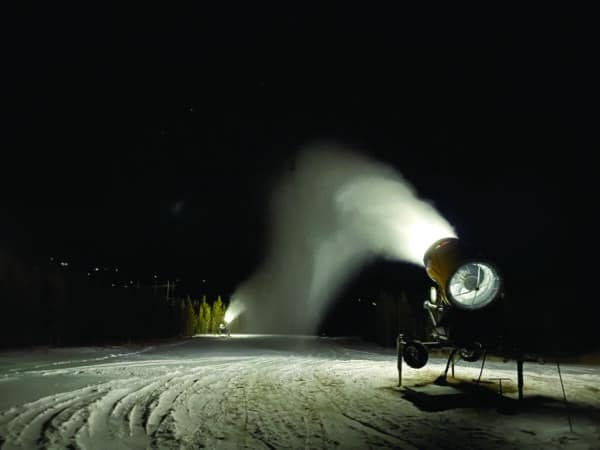
ACCORDING TO THE GALLATIN RIVER TASK FORCE, the most cost-effective and sustainable way to address drought and protect the Gallatin River is through water conservation. In Big Sky, every gallon of water saved or reused directly contributes to the health of the river and the watershed. That’s where snowmaking with reclaimed water comes in. Man-made snow boosts the snowpack, and because it is denser than natural snow, it delays runoff in the spring, helping to keep the watershed and aquifer healthy. The Yellowstone Club project, says Rich Chandler, Director of Environmental Operations for the YC, is about water conservation and the beneficial use of a scarce resource. Chandler also notes that man-made snow from reclaimed water is safe to ski and recreate on. This winter at the YC, another 35,000 linear feet of pipe with 66 different connections to snowmaking guns will take reclaimed water from the pond on top of the golf course to make snow on 55 skiable acres. That man-made snowpack will deliver a 25 million gallon benefit to the aquifer and watershed.
LONE MOUNTAIN LAND COMPANY AND MSU BRING A TEACHING HOTEL TO CAMPUS
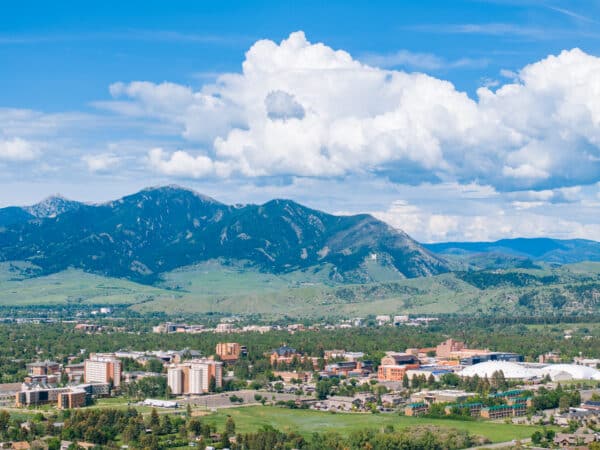
The Montana State University campus in Bozeman, Montana, where the Marriott Tribute Hotel will be built to further students’ careers in hospitality. Photo by Joe Esenther
MONTANA IS BOOMING, but as fast as it’s growing, the state still experiences a brain drain when its college- educated youth leave in search of work. Montana State University’s Hospitality Management program and Lone Mountain Land Company hope to help change that by developing a campus “teaching hotel.” THE VIM will be a Marriott Tribute Hotel developed by LMLC on a 40-year land lease. The hotel’s name comes from the MSU Bobcat’s fight song: “We’ve got the vim, we’re here to win.” (In the old expression “vim and vigor, vim means energy or pluck.) Once THE VIM opens, students will work alongside seasoned hoteliers as they get hands-on training in hospitality management, culinary arts, marketing, engineering, design, retail, and construction. THE VIM is expected to break ground in late 2024 or early 2025. The clientele? Visiting faculty, students, parents, alumni, and donors. Aesthetically, the hotel will honor the historic architecture of the University and downtown Bozeman with brick facades and arched windows. A rooftop Alumni Club—with its private dining bar, hot tub, cold plunge, fitness center, sauna, and steam room—will serve as a philanthropy hub. There will be discounted rates available to welcome parents and students. “With a three-meal restaurant, cafe, marketplace, and official Bobcat-themed store, MSU will not only promote their brand, but offer classes that train kids to stay and become part of Montana’s driving economic force,” says LMLC’s Vice President of Planning and Development, Bayard Dominick.
BIG SKY COMMUNITY ORGANIZATION GOES “ALL OUT” ON TRAILS AND PARKS
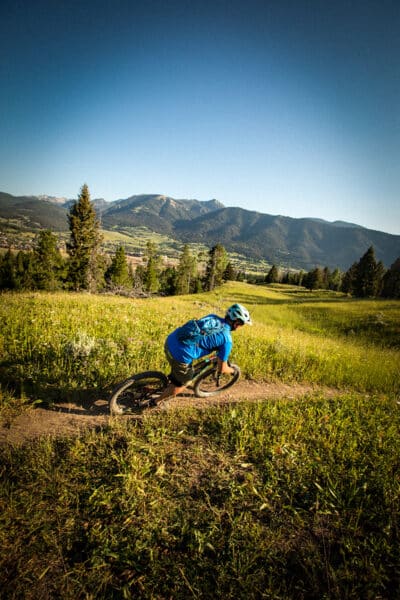
Biker riding one of the diverse BSCO trails.
Photograph by Tibor Nemeth
THIS PAST SUMMER, the Big Sky Community Organization (BSCO) celebrated its 25th anniversary and launched its “All Out for Parks & Trails Campaign’’ with the goal of serving residents and visitors alike. With this campaign, BSCO has three key initiatives: the creation of a new multi-use park for all ages and abilities; improving and expanding existing athletic fields and courts; and enhancing the existing trail network to ensure the safety and enjoyment of cyclists and pedestrians by building new multi-use recreational trails to meet increasing demand.
BSCO believes that community building happens through recreation. Expected to break ground in 2024 on land donated by LMLC in summer 2023, a new park will be constructed for the public off Ousel Falls Road which will repurpose six acres into a community hub. Initial plans show a dog park, lawn game area, picnic shelters, playground, and a full basketball court with a small plaza and seating. Cornhole boards with boulder seating, and a multi-use playing field suitable for everything from soccer to ultimate frisbee will round out the site. “The park will serve the entire population of Big Sky,” says BSCO CEO, Whitney Montgomery.
Existing parks will be modernized and receive a significant renovation, too. BSCO will expand the skate park and pump track to include a jump-line to practice skills. Existing athletic fields will be expanded and upgraded to provide a longer playing season, and a new adventure based, ADA accessible, playground designed for multiple ages and abilities will become a hangout for young families.
Other initiatives include adding 20 miles of multi-use recreational trails and improving in-town paths and trails to ensure a safer experience for pedestrians and cyclists. Ultimately, BSCO’s campaign will bring everyone in Big Sky “All Out”—connected, healthy, and thriving.
BIG SKY COMMUNITY PARTNERS FIND CHILDCARE SOLUTIONS
LAST SPRING, AS SCHOOL YEAR CALENDARS COUNTED DOWN, many Big Sky families were struggling to find quality, affordable childcare for the summer months. In a poll conducted by the Big Sky Child Care Task Force, more than 35 families indicated a need for childcare for four to five-year- olds. Hannah Waterbury, Executive Director of Spanish Peaks Community Foundation says that although a lack of affordable childcare is a national and statewide issue, it particularly affects Big Sky residents. She notes that more than 96 percent of women who live in Big Sky work, and those with children spend $1,733 monthly—16 percent of their median income— on childcare. Moreover, says Waterbury, the 50 percent of Big Sky’s workforce that commutes also face a need for childcare. Montana is one of only a handful of states that does not offer public pre-kindergarten. And Big Sky has only one full-time, year-round childcare facility—Morningstar Learning Center. These collective challenges make it difficult for families to live in Big Sky. They also make it hard for businesses to retain middle management employees.
Recognizing the urgency, Big Sky’s private, philanthropic, and public entities joined forces. Employing spaces donated by Big Sky School District #72, the Lone Mountain Land Company, Spanish Peaks Community Foundation, and Yellowstone Club Community Foundation worked tirelessly to launch the Big Sky Summer Camp for preschoolers.
But that was just one piece of the puzzle. “When Lone Mountain Land Company became aware of the need for childcare, they stepped in to help,” says Waterbury.
Morningstar needed more resources. Applying for a Childcare Innovation and Infrastructure Grant, funded by The American Rescue Plan Act and the Montana Department of Health and Human Services was the best option. In order to receive the $1 million dollar grant, Morningstar needed a 10 percent corporate match. That’s where LMLC was able to help. While Morningstar only ended up receiving $413,904 of its request, LMLC still matched its $100,000 commitment. The funds were the next piece of the puzzle for helping to address Big Sky’s childcare needs. Ultimately, more expansion will be necessary.
COMMUNITY HOUSING COMING TO BIG SKY
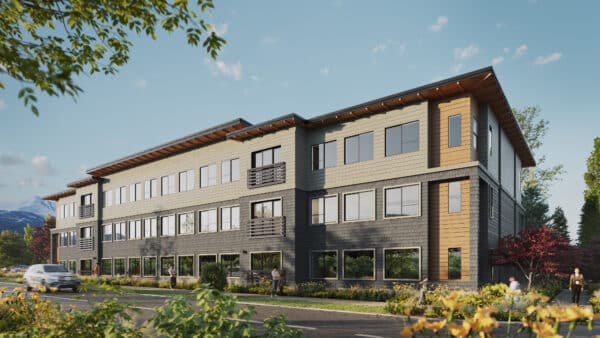
A rendering of the RiverView Place development.
Rendering courtesy of Lone Mountain Land Company
WORKING WITH MULTIPLE PARTNERS, LMLC wants to ensure that the people who work in Big Sky can also call it home. To date, hundreds of millions of dollars has been earmarked to address community housing initiatives.
RiverView Place is slated to house 387 locals in 97 units in 2024. Featuring a mix of 1, 2, and 3-bedroom apartments, as well as shared living suites, RiverView residents will find affordable housing within walking distance to amenities such as playgrounds, pickleball courts, as well as athletic fields in the Community Park and restaurants, nightlife, fitness centers, and other critical retail services in the Town Center and Meadow Village shopping districts. The deed-restricted residential development ties directly into Big Sky’s extensive trail network and features a Skyline Connect bus stop that is expected to ease vehicular traffic. The housing complex focuses on sustainable building practices with low-flow plumbing fixtures and solar panels, and even includes covered bike storage to encourage residents to consider alternate modes of transportation.
“Affordable housing in mountain towns remains a critical need without a clear solution,” says LMLC’s Cryder Bancroft. “Through collaborative partnerships with the Big Sky Housing Trust and the Resort Tax, LMLC is working to ensure anyone who works in Big Sky can also live in Big Sky.” The upcoming Gateway Village development in Gallatin Gateway will offer 323 3-and 4-bedroom units catering to workers who prefer commuting to Big Sky. Meanwhile, the design sports a mountain-modern aesthetic and Gateway Village will look and feel like a mountain community.
WINTER LIGHTS & DELIGHTS: TOWN CENTER FRIDAYS
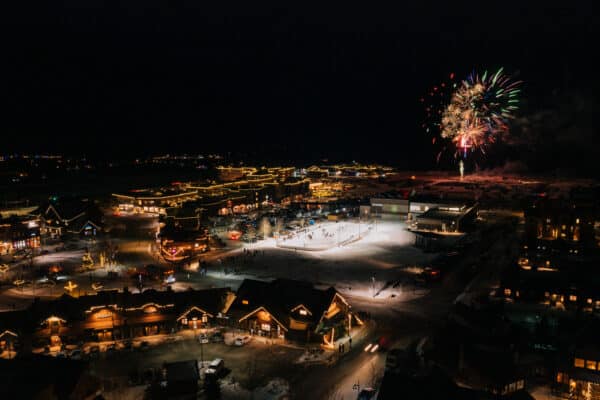
Photograph by Joe Esenther
EXPERIENCE THE ENCHANTMENT of Big Sky Town Center every Friday between 4–7pm from December 22 to the end of March. Immerse yourself in a lively atmosphere where local retailers, restaurants, bars, and art galleries offer exclusive specials, retail raffles, local musicians, and more. Friday nights in Town Center are the place to be this winter season!
BIG SKY’S TOWN CENTER WELCOMES SIX NEW SHOPS AND RESTAURANTS
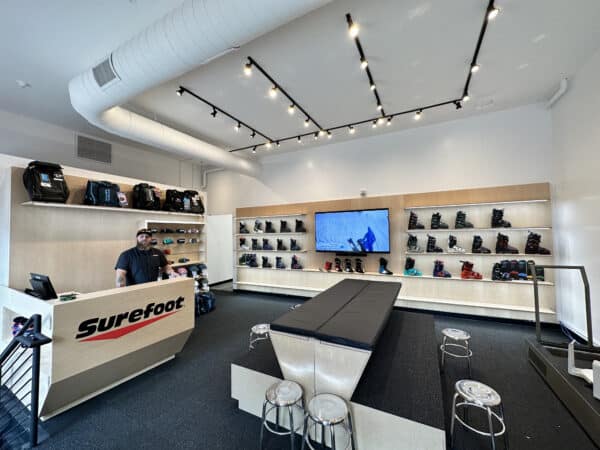
Inside the new Surefoot boot fitting store in Town Center.
Photograph by Cryder Bancroft
Town Center gets more vibrant every year. The town is already rich with well-established shopping, dining, and nightlife. This winter brings even more.
– Got nagging pains in your ski boots? A Surefoot boot fitting store is now open at 47 Town Center Ave.
– Need a top-of-the-line chef ’s knife to round out your professional kitchen? The craftspeople at the renowned New West KnifeWorks will set you up.
– Got young ones coming to town? Cut back on their screen time when they’re indoors with a visit to The Great Rocky Mountain Toy Company, a southwestern Montana standout shop from Bozeman.
– With an eye on premium men’s and women’s lifestyle and outdoor apparel, Bluebird is a must hit for your four season casual wear.
– For those who don’t want to head to the base area to load up on Big Sky Resort logo wear, you can now pop right over to the new Big Sky Resort Store in Town Center.
– All that shopping will make you hungry, which is where another Bozeman transplant, Thai Basil, comes in. The Deep Fried Tiger Bombs—crab, cream cheese, onion, green onion, and carrot deep fried in a wonton paper sound like the bomb.
These new additions add to the already 35 established Town Center restaurants, bars, outfitters, and boutiques.
A Careful Appreciation of the Porcupine
They’re big-appetite herbivores with powerful incisors similar to a beaver’s who favor a diet of tree bark, the sub-bark layer cambium, roots, and tubers.
In the pantheon of small Rocky Mountain mammals, the porcupine falls somewhere between the wee, squeaky pika foraging to the side of an alpine trail, and the raccoon raiding your garbage. Cute, but not too cute. Best avoided, but still kind of cool to encounter from a safe distance.
Will you? Porcupines are common enough around Big Sky to get a major creek and trail named for them, as everyone who has hiked or biked Porcupine Creek Trail knows. But the truth is, the North American porcupine is primarily a solitary night forager and lives much of its life up in the trees. They’re a bit elusive. “I spend a ton of time in the woods, but I rarely see them,” says Andrea Saari, cofounder of Big Sky Adventures & Tours. “It’s my dogs who have encounters. I see the aftermath— the vet bills.”
Maybe a more apt question is: Should you want to encounter a porcupine? To that we give a big, hearty, slightly qualified, yes.
That’s partly because they’re really darn cute. Sweet eyes, button nose, soft fur (yes, really). It’s also worth seeing porcupines because they’re fascinating examples of evolution. They’re big- appetite herbivores with powerful incisors similar to a beaver’s who favor a diet of tree bark, the sub-bark layer cambium, roots, and tubers. They were once blamed for causing forest loss, and in the dark days of the 1950s to the ’70s, voracious porcupines were the target of ill-advised eradication efforts.
Now, about those quills, all 30,000 of them per animal. You might not actually see them from a few yards off. When you behold a porcupine in full bushy grandeur, you’re seeing fur: a soft outer layer and a second layer for warmth. The quills, which are technically hollow hairs, lie underneath. Yes, they are incredibly sharp. No, porcupines can’t shoot them. But if you touch—or if you are a dog, sniff—a porcupine it will raise and swing its spiky weaponized tail and you’ll get a painful cluster of them in your hand or snout. Just ask Andrea’s dogs.
The quills are sharper than hypodermics, and they’re scaled and barbed like fish hooks. The quills break free of the animal upon impact, leaving a victim looking like a pin cushion. If you’re stuck, get to the ER. If it’s your pooch, get right to the vet. When quills break off inside of dogs, they can migrate for years through soft tissue, eventually endangering vital organs. If you’re way off the grid, you might want to start plucking with a Leatherman tool. Given the risks—which really should only involve our dumb canine friends— and the fact that porcupines don’t hibernate, a great way to observe them is from a chairlift adjacent to a pine forest in winter.
Doug Rand, a retired landscape architect from Gallatin Gateway, sees them fairly often eating trees around his home. He once encountered two angry porcupines in a face-off, both noses festooned with quills. “Pure agony for both.” The males fight with tooth and quill for dominance. The victor sprays the female with urine to mark her as betrothed. Doug, using a spade for a prod and staying well clear of the quills, herds them into a wooden box, and ushers them to the backcountry.